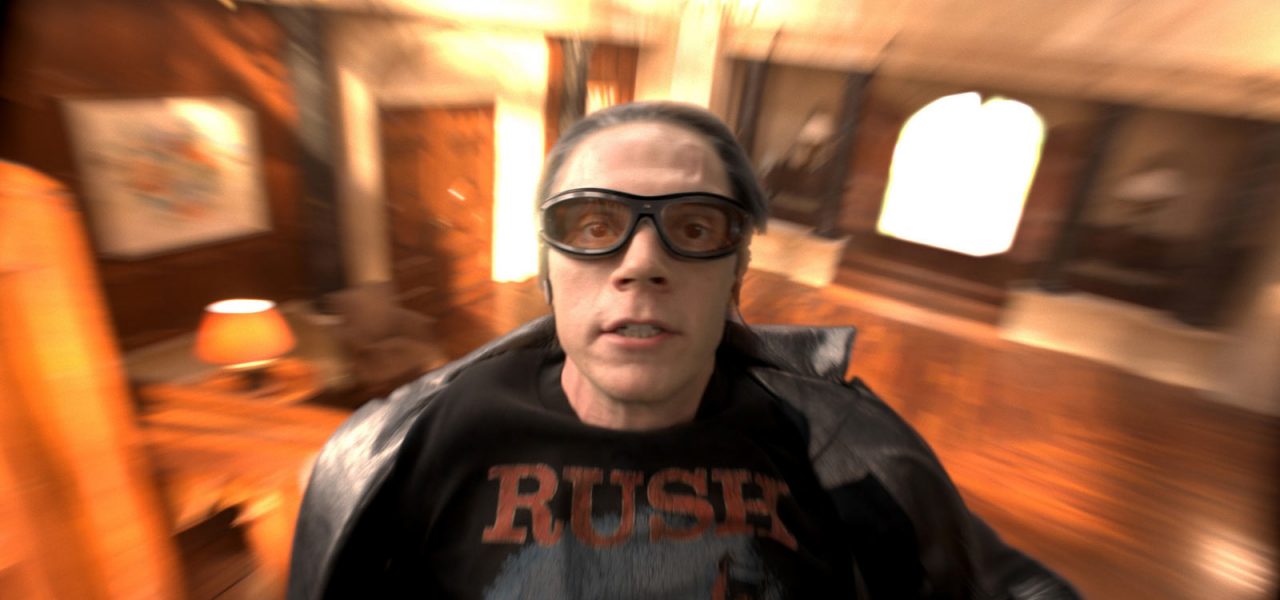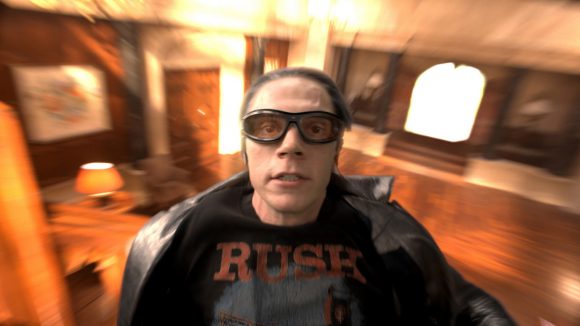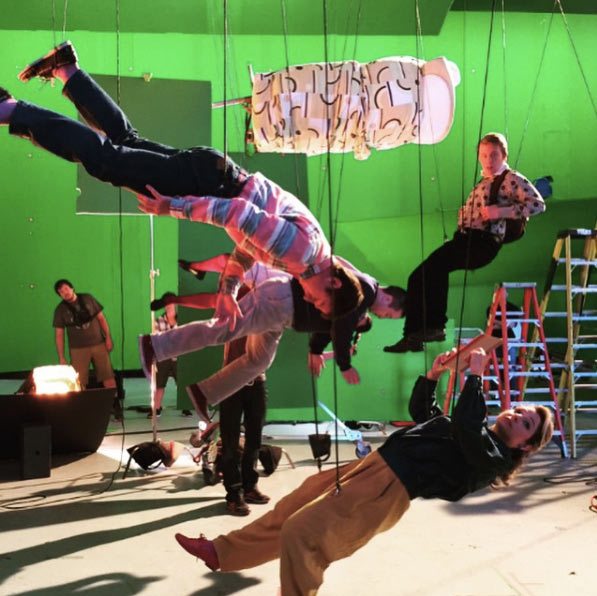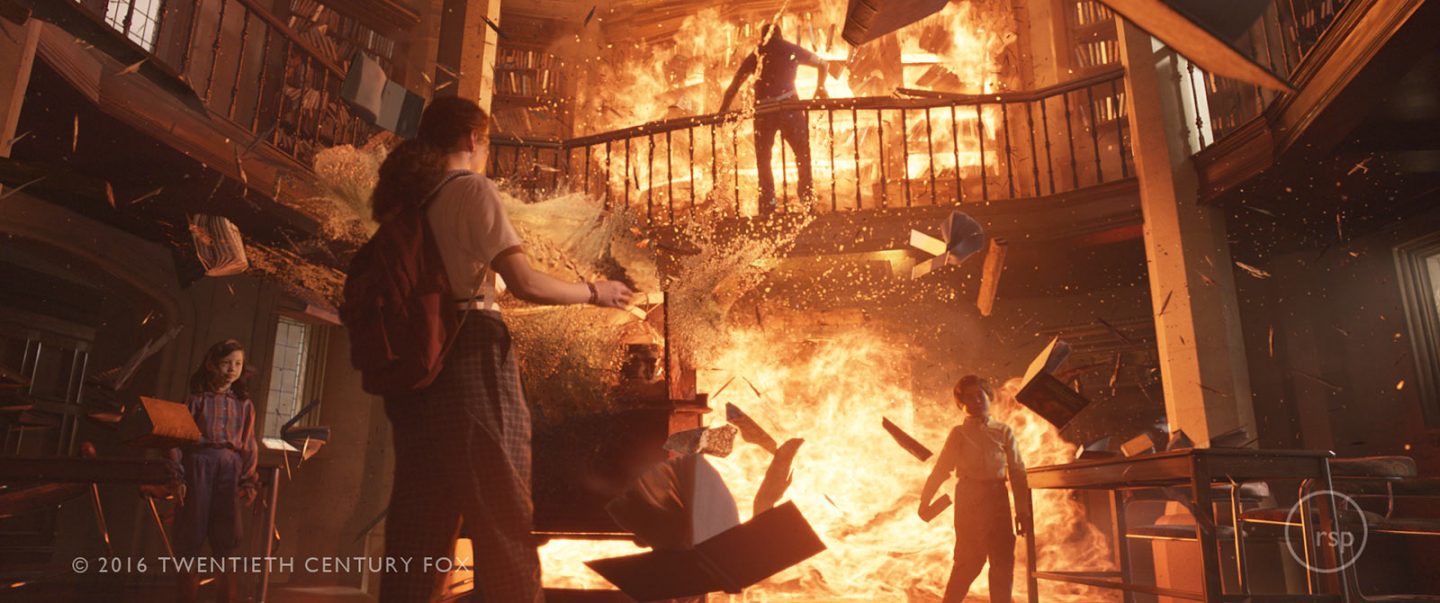

How They Made That ‘X-Men: Apocalypse’ Scene Everyone Is Talking About
If there’s one thing in Bryan Singer’s X-Men: Apocalypse that’s got everybody talking, it’s the mansion rescue sequence that showcases the powers of supersonic mutant, Peter Maximoff (aka Quicksilver) played by Evan Peters.
Already a hit from Days of Future Past, Quicksilver returns in slow- and fast-motion to save scores of students from a deadly blast, all while he is listening to Sweet Dreams (Are Made of This) by Eurythmics. Every little detail of the explosion is visible to the audience, thanks to Adelaide, Australia-based visual effects studio Rising Sun Pictures. Here’s how they pulled it off.
Quicksilver in action
In the previous film, Quicksilver’s skills were on display in the White House kitchen. In Apocalypse, that single room was expanded to most of the campus of Professor Xavier’s School for Gifted Youngsters. That meant more locations, more slow-motion gags, and, since there would be a blast erupting throughout the whole sequence, much more visual effects work.
Still, the filmmakers, including overall visual effects supervisor John Dykstra, looked to acquire as many of the shots as possible in-camera. Filming therefore took place at the mansion location and on sets where high-speed reference of furniture, walls and even a fish tank exploding was gathered. Additionally, shots of the students mid-motion on wires on sets and against greenscreen was captured. Rising Sun Pictures—which also worked on the Quicksilver shots in Days of Future Past—would then augment this photography with occasional digital doubles, evidence of the mutant’s ‘zipping’ abilities, fire blasts, and the exploding elements.

For shots of the students mid-air or mid-action before Quicksilver grabs them, actors were filmed carefully holding their poses or supported on wires, especially if they were being affected by the blast. One shot has them in the lobby area as the floor rises up from the explosion. This shot was achieved by “filming the kids on a piston setup that raised them up,” explained Rising Sun Pictures visual effects supervisor Dennis Jones. “But when we got our digital floor in, it was more of a convex surface and we had to change their perspective a little.”
A later shot sees Quicksilver hoist students out of the mansion windows. That was filmed via motion control using multiple passes. The actors, fitted with wires, were shot against greenscreen as they were launched out the window. Here, Rising Sun’s challenge was to make it look as if the students were not on wires for the requisite ‘freeze frame’ moments—“You get a rock and roll effect as they ease on the wires,” said Jones. The solution was to take still frames of the students and project those back onto their bodies. This allowed them to be stabilized correctly.
The art of zipping
In order to realize Quicksilver’s lightning speeds (and the effect that has on what the audience sees), the visual effects team had to devise a language for the mutant. In particular, they had to show him doing physical movements that did not make sense in the physical world but helped sell the fast motion. “As he moves things,” said Jones, “those things inherit his velocity but then they slow down very quickly—that’s part of the Quicksilver lore.”

Similarly, artists had to communicate the speed at which Quicksilver moves without just turning him into a blur. Rising Sun called these the ‘zip zip moments’ and strove to make them always readable. The zip zip moments ultimately became a mixture of smears and a leading edge shape that was recognizable as Quicksilver with a trail that lingers briefly to let the audience follow him in a scene.
For example, in the library Quicksilver zips up and down to rescue several students and is seen with a residual trail behind him. “To do that,” stated Jones, “we rendered two passes of motion blur, one standard where we opened up the shutter to allow multiple frames and got long smeary frames, and one where we rendered the frames at half speed and put them together to get the smoothness back.”
Only occasionally was Peters realized as a fully digital double, but this was required for a few shots. One has Quicksilver running through the mansion, eating a pizza, and picking up a dog (actually a scanned-in representation of a French bulldog, Tauntan, owned by previs supervisor Rpin Suwannath)—all were CG characters at some point in the shot.

Chaos and destruction: in slow-mo
As the mansion sequence progresses, more and more of the blast becomes apparent, albeit very slowly, until a final explosive crescendo. The challenge for Rising Sun, then, was to find a way to include the explosions and destruction very incrementally. The studio began with real slow-motion reference of fireballs and a fish tank. They also looked to previous on-screen explosions in films like The Dark Knight and Bad Boys II. “We noticed in Bad Boys II that you could see the concussion effect on the roof tiles so we even added that ripple effect to our shots,” said Jones.
Another observation of these film references came in what Jones describes as the ‘germs’ of the blast, the small trailing fiery lumps which are often the result of the special effects crew clumping in packs of dirt and material to make explosions more dramatic.

With these references in mind, Rising Sun developed pyro simulations using Side Effects Software’s Houdini. One might think that these would be incredibly complicated and time-consuming to render. But since the real-time version of the explosions only happened over 8-12 frames, that’s exactly how long the simulations were orchestrated to be.
The trick came, however, in then using Houdini to interpolate the simulation frames over the full length of the shot. The studio wrote specific tools to make this possible. “What we were doing was solving for say 10 frames and then stretching that out,” explained Jones. “That became a velocity field for a higher resolution pass, and then you inject a higher res detail into that velocity field. It lets you get the real time motion as slow motion in high fidelity.”
The explosions in the sequence take their time to emerge, meaning Rising Sun could use separate shots to show how it was ramping up in intensity. Artists treated the explosions almost like pressure waves that were kicking up dust. The blast was also visualized as having a leading edge of velvety dust with a fireball almost secondary to it. Then as the sequence progresses the look became more and more akin to a raging ball of fire. In addition to the pyro simulations, Rising Sun also needed to destroy things. Again, the studio looked to Houdini for this work, building around 80 props for digital destruction.

The playful superhero
The final result is a frenetic and breathtaking scene, highlighted by so many critics and filmgoers as the stand-out sequence in the film. For Rising Sun Pictures, it was also one in which they sought to outdo their earlier work, and a chance to make Quicksilver even more playful. “There’s that sense that he’s almost failing,” said Jones. “But he’s still being his playful self—eating pizzas, doing a loop de loop. Then there’ll be say a brick coming in about to kill a kid before he just whips them out! It just meant we could have more fun with the scene.”

.png)